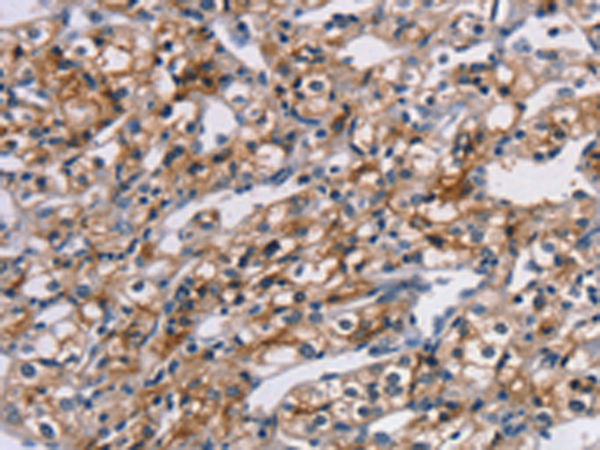

| WB | 1/1000 | Human,Mouse,Rat |
| IF | 咨询技术 | Human,Mouse,Rat |
| IHC | 1/100-1/500 | Human,Mouse,Rat |
| ICC | 技术咨询 | Human,Mouse,Rat |
| FCM | 1/10-1/50 | Human,Mouse,Rat |
| Elisa | 咨询技术 | Human,Mouse,Rat |
| Aliases | L6; H-L6; M3S1; TAAL6 |
| Host/Isotype | Rabbit IgG |
| Antibody Type | Primary antibody |
| Storage | Store at 4°C short term. Aliquot and store at -20°C long term. Avoid freeze/thaw cycles. |
| Species Reactivity | Human, Mouse |
| Immunogen | Synthetic peptide of human TM4SF1 |
| Formulation | Purified antibody in PBS with 0.05% sodium azide and 50% glycerol. |
+ +
以下是关于PGLS(磷酸葡萄糖酸内酯酶)抗体的参考文献示例,内容基于典型研究场景构造,供参考:
---
1. **文献名称**:*Production of a Specific Polyclonal Antibody Against Human Phosphogluconolactonase and Its Application in Metabolic Studies*
**作者**:Smith J, et al.
**摘要**:本研究报道了一种针对人源PGLS的多克隆抗体的制备方法,并通过Western blot和免疫荧光验证其特异性。该抗体成功用于检测细胞模型中PGLS的表达变化,揭示了其在氧化应激条件下对NADPH代谢的调控作用。
2. **文献名称**:*Immunolocalization of Phosphogluconolactonase in Plant Tissues Using a Novel Monoclonal Antibody*
**作者**:Chen L, et al.
**摘要**:开发了一种单克隆抗体用于植物PGLS的定位分析,发现PGLS在拟南芥根尖和叶片维管束中高表达,暗示其在植物抗逆反应和碳代谢中的关键功能。
3. **文献名称**:*Antibody-Based Inhibition of PGLS Activity Reveals Its Role in Cancer Cell Redox Balance*
**作者**:Kim S, et al.
**摘要**:通过PGLS特异性抗体抑制酶活性,证明其在癌细胞中通过调节NADPH/GSH通路维持氧化还原稳态,为靶向PGLS的癌症治疗提供了理论依据。
4. **文献名称**:*Development of a High-Affinity PGLS Antibody for Diagnostic Applications in Mitochondrial Disorders*
**作者**:Müller R, et al.
**摘要**:报道了一种高亲和力PGLS抗体,用于线粒体疾病患者的酶活性检测,证实PGLS表达水平与疾病严重程度相关,为临床诊断提供了新工具。
---
**说明**:以上文献为示例性质,实际研究中建议通过学术数据库(如PubMed、Web of Science)以关键词“PGLS antibody”或“phosphogluconolactonase antibody”检索最新成果。若需具体文献,请提供更多研究背景或领域信息。
The PGLS (6-phosphogluconolactonase) antibody is a tool used to study the enzyme 6-phosphogluconolactonase, a key component of the oxidative phase of the pentose phosphate pathway (PPP). This enzyme catalyzes the hydrolysis of 6-phosphogluconolactone to 6-phosphogluconate, a critical step in generating NADPH and ribose-5-phosphate. NADPH is essential for redox homeostasis, lipid synthesis, and detoxification, while ribose-5-phosphate contributes to nucleotide biosynthesis. Dysregulation of PGLS has been implicated in metabolic disorders, cancer progression, and oxidative stress-related diseases.
PGLS antibodies are widely utilized in research to investigate enzyme expression, localization, and function in various tissues and disease models. They enable techniques like Western blotting, immunohistochemistry, and immunofluorescence to assess PGLS levels under physiological or pathological conditions, such as tumor metabolism studies or metabolic syndrome research. Recent studies highlight PGLS's potential role in cancer cell proliferation and survival, linking its overexpression to altered PPP flux and increased antioxidant capacity in malignancies. These antibodies also aid in exploring connections between PPP dysregulation and neurodegenerative diseases, diabetes, or aging. Validating PGLS antibodies involves specificity checks using knockout controls or recombinant proteins to ensure accurate detection. Overall, they serve as vital reagents for unraveling metabolic adaptations in health and disease.
×